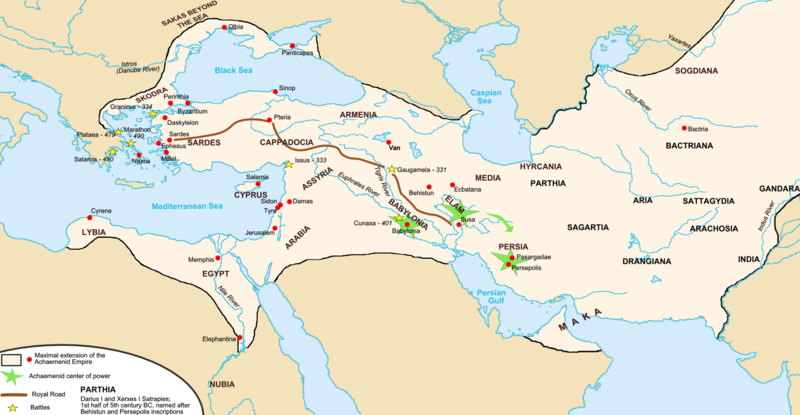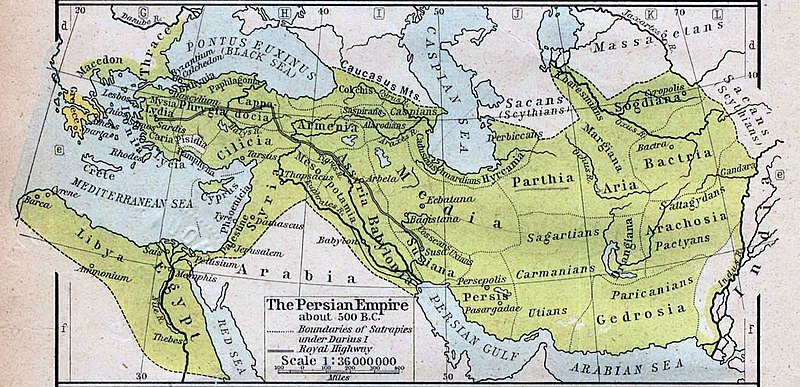Dinastía XXXI de Egipto - Español
De Wikipedia, la enciclopedia libre
La dinastía XXXI, también denominada segunda dominación persa de Egipto, transcurre de 343 a 332 a. C.
Pertenece al final del periodo tardío de Egipto, que comprende las dinastías XXVI, XXVII, XXVIII, XXIX, XXX y XXXI.
Contenido |
Historia [editar]
En este periodo de nueve años Egipto fue un país ocupado por gobernantes extranjeros y muchos textos coetáneos indican que fue una época de violencia y opresión.
El segundo periodo de dominación persa tuvo tres reyes: El primero fue Artajerjes III que en 343 a. C. derrotó a Nectanebo II, el último faraón de la dinastía XXX, y aunque fue asesinado por su propio general, en 338 a. C., le sucedió en el trono su hijo Arsés.
Durante el reinado de Arsés, al menos un personaje egipcio reclamó el trono, pero él lo hizo desistir, y apenas fue mencionado en los documentos; su nombre, Jabebesh, puede ser libio, y aunque tuvo algunos seguidores en el Alto Egipto nunca gobernó realmente sobre el país. Es probable que en esta época hubiera otros pretendientes al trono.
Darío III fue el tercer y último gobernante de esta dinastía. Subió al trono del imperio persa336 a. C. con el deber de salvar un imperio que estaba debilitándose, pero en 334 a. C. tuvo que enfrentar su mayor reto: Alejandro Magno, el recién nombrado Hegemon por la liga de Corinto invadió Persia: la guerra había comenzado. el
Dario viendo que su ejército era derrotado una y otra vez, se puso a la cabeza para intentar detener el avance de Alejandro, pero en la batalla de Issos (12 de noviembre de 333 a. C.) la victoria fue de Alejandro.
Este hecho fue crucial, pues para que Alejandro pudiera avanzar hacia el corazón del imperio tenía que asegurarse la retaguardia conquistando el Oriente Próximo y Egipto, aún bajo dominio persa, tarea que emprendió a inicios de 332 a. C. con el asedio de Tiro que resistió seis meses; después se dirige rápidamente a Egipto donde después de vencer lo que quedaba del ejército persa se proclama "Hijo de Amón" y reorganiza sus territorios para darles mayor cohesión; luego retoma la conquista de un imperio persa que no gobernaría nunca más sobre Egipto. Alejandro Magno de esta forma expulsaba al imperio persa de Egipto y fundaba una nueva dinastía, la Dinastía Macedónica.

Faraones de la dinastía XXXI de Egipto [editar]
| Nombre | Comentarios | Reinado |
|---|---|---|
| Artajerjes III | Convirtió Egipto en satrapía Persa. Fue asesinado por su visir Bagoas | 341 - 338 a. C. |
| Arsés | Hijo de Artajerjes. Soberano títere, manejado por Bagoas | 338 - 336 a. C. |
| Darío III | Último rey persa, aqueménida. Derrotado por Alejandro Magno | 336 - 332 a. C. |
Cronología de la dinastía XXXI [editar]
Cronología estimada por los egiptólogos:
- Primer faraón: Artajerjes III Ocos, c. 342/1 - 338 a. C.
- Último faraón: Darío III Codomano, c. 336/5 - 332 a. C.
Cronograma [editar]

Referencias [editar]
- Referencias digitales
- (en inglés) http://www.digitalegypt.ucl.ac.uk//Welcome.html
- (en inglés) http://www.ancient-egypt.org/index.html
- (en inglés) http://www.narmer.pl/indexen.htm
- (en inglés) http://www.phouka.com/pharaoh/pharaoh/pharaohs.html
- (en alemán) http://www.eglyphica.de/egpharaonen
- (en francés) http://2terres.hautesavoie.net/cegypte/texte/chronolo.htm
Enlaces externos [editar]
 Wikimedia Commons alberga contenido multimedia sobre Dinastía XXXI de Egipto.
Wikimedia Commons alberga contenido multimedia sobre Dinastía XXXI de Egipto.- Genealogía, Reyes y Reinos: Dinastía XXXI de Egipto
| Dinastía precedente | Periodo tardío de Egipto | Dinastía siguiente |
|---|---|---|
| Dinastía XXX | Dinastía XXXI | Dinastía Macedónica |
History of Persian Egypt - Inglés
From Wikipedia, the free encyclopedia
| History of Egypt | |
|---|---|
 This article is part of a series | |
| Ancient Egypt | |
| Persian Egypt | |
| Ptolemaic Egypt | |
| Roman Egypt | |
| Christian Egypt | |
| Muslim Egypt | |
| Ottoman Egypt | |
| Muhammad Ali dynasty | |
| Modern Egypt | |
| Egypt Portal |
The history of Persian Egypt is divided into three eras: an initial period of AchaemenidPersian occupation when Egypt became a satrapy, followed by an interval of independence; a second period of occupation, again under the Achaemenids; and a final occupation by the Sassanid Empire, immediately before the Muslim invasion of AD 639.
Contents |
[edit] Achaemenid Egypt
The last pharaoh of the Twenty-Sixth dynasty, Psamtik III, was defeated by Cambyses II of Persia in the battle of Pelusium in the eastern Nile delta in 525 BC. Egypt was then joined with Cyprus and Phoenicia in the sixth satrapy of the Achaemenid Empire. Thus began the first period of Persian rule over Egypt (also known as the 27th Dynasty), which ended around 402 BC.
After an interval of independence, during which three indigenous dynasties reigned (the 28th, 29th, and 30th dynasty), Artaxerxes III (358–338 BC) reconquered the Nile valley for a brief period (343–332 BC), which is called the thirty-first dynasty of Egypt.
[edit] The first Egyptian satrapy
Cambyses led three unsuccessful military campaigns in Africa: against Carthage, the oases of the Western Desert, and Nubia. He remained in Egypt until 522 BC and died on the way back to Persia. The Greek and Jewish sources, especially Herodotus and Diodorus Siculus, present us a bleak portrait of Cambyses' rule, describing the king as mad, ungodly, and cruel. It is impossible unfortunately to compare these texts with Egyptian sources, as all unofficial documents appear doing their best to ignore Cambyses' existence. Herodotus may have drawn on an indigenous tradition that reflected the Egyptians' resentment, especially of the clergy, of Cambyses' decree (known from a Demotic text on the back of papyrus no. 215 in the Bibliotheàque Nationale, Paris) curtailing royal grants made to Egyptian temples under Ahmose II.
In order to regain the support of the powerful priestly class, Darius I (522–486 BC) revoked Cambyses' decree. Diodorus reported that Darius was the sixth and last lawmaker for Egypt; according to Demotic papyrus no. 215, in the third year of his reign he ordered his satrap in Egypt, Aryandes, to bring together wise men among the soldiers, priests, and scribes, in order to codify the legal system that had been in use until the year 44 of Ahmose II (c. 526 BC). The laws were to be transcribed on papyrus in both Demotic and Aramaic, so that the satraps and their officials, mainly Persians and Babylonians, would have a legal guide in both the official language of the empire and the language of local administration. To facilitate commerce, Darius built a navigable waterway from the Nile to the Red Sea (from Bubastis [modern Zaqaziq] through the Wâdî Tûmelât and the Bitter Lakes); it was marked along the way by four great bilingual stelae, the so-called "canal stelae," inscribed in both hieroglyphics and cuneiform scripts.
In 1972 archaeological excavations at Susa brought to light a stone statue of Darius I, standing and wearing a sumptuous Persian garment; it is inscribed in cuneiform (in Old Persian, Elamite, and Akkadian) and in hieroglyphics. This can be interpreted as a recognition of the role of Egypt in the Empire.
Shortly before 486 BC, the year of Darius' death, there was a revolt of the type that had occurred under Aryandes, that was definitively subdued by Xerxes I (486–464 BC) only in 484 BC. The province was subjected to harsh punishment for the revolt, and especially its satrap Achaemenes administered the country without regard for the opinion of his subjects.
A still more serious and extensive revolt took place in about 460 BC under Artaxerxes I. It was led by the Libyan Inaros, son of Psamtik III (Thucydides 1.104), who asked for help from Athens; a fleet of 200 ships sailed up the Nile as far as the ancient citadel of Memphis, two thirds of which was occupied by the insurgents. Achaemenes was killed in the course of the battle of Papremis in the western Delta.
[edit] The second Egyptian satrapy
It is not known who served as satrap after Artaxerxes III, but under Darius III (336–330 BC) there was Sabaces, who fought and died at Issus and was succeeded by Mazaces. Egyptians also fought at Issus, for example, the nobleman Somtutefnekhet of Heracleopolis, who described on the "Naples stele" how he escaped during the battle against the Greeks and how Arsaphes, the god of his city, protected him and allowed him to return home.
In 332 BC Mazaces handed over the country to Alexander the Great without a fight. The Achaemenid empire had ended, and for a while Egypt was a satrapy in Alexander's empire. Later the Ptolemies and the Romans successively ruled the Nile valley.
[edit] Sassanid Egypt

The Persian conquest of Egypt, beginning in 619 or 618, was one of the last SassanidByzantium. Khosrow II Parvêz had begun this war in retaliation for the assassination of Emperor Maurice (582-602) and had achieved a series of early successes, culminating in the conquests of Jerusalem (614) and AlexandriaHeraclius in the spring of 622 shifted the advantage, however, and the war was brought to an end by the fall of Khosrow on 25 February 628.[1] Khosrow's son and successor, Kavadh II Šêrôe (Šêrôy), who reigned until September, concluded a peace treaty officially returning territories conquered by the Sassanids to the Byzantine Empire. achievements in the Roman-Persian Wars against (619). A Byzantine counter-offensive launched by Emperor
The Persian conquest allowed Monophysitism to resurface in Egypt, and when imperial rule was restored by Emperor Heraclius in 629, the Monophysites were persecuted and their patriarch expelled. Egypt was thus in a state of both religious and political turmoil when a new invader appeared.
[edit] References
- ^ Frye, pp. 167-70
- Herodotus (Histories)
- Fragments of Ctesias (Persica)
- Thucydides (History of the Peloponnesian War)
- Diodorus Siculus (Bibliotheca historica)
- Fragments of Manetho (Aegyptiaca)
- Flavius Josephus (Antiquities of the Jews)
| ||||||||||




No hay comentarios:
Publicar un comentario